
The trogons and quetzals are birds in the order Trogoniformes which contains only one family, the Trogonidae. The family Trogonidae contains 46 species in seven genera. The fossil record of the trogons dates back 49 million years to the Early Eocene. They might constitute a member of the basal radiation of the order Coraciiformes and order Passeriformes or be closely related to mousebirds and owls. The word trogon is Greek for "nibbling" and refers to the fact that these birds gnaw holes in trees to make their nests.

The Coraciiformes are a group of usually colourful birds including the kingfishers, the bee-eaters, the rollers, the motmots, and the todies. They generally have syndactyly, with three forward-pointing toes, though in many kingfishers one of these is missing. The members of this order are linked by their “slamming” behaviour, thrashing their prey onto surfaces to disarm or incapacitate them.

The mousebirds are birds in the order Coliiformes. They are the sister group to the clade Eucavitaves, which includes the Leptosomiformes, Trogoniformes (trogons), Bucerotiformes, Piciformes and Coraciformes. This group is now confined to sub-Saharan Africa, and it is the only bird order confined entirely to that continent, with the possible exception of turacos which are considered by some as the distinct order Musophagiformes, and the cuckoo roller, which is the only member of the order Leptosomiformes, and which is found in Madagascar but not mainland Africa. Mousebirds had a wider range in the Paleogene, with a widespread distribution in Europe and North America during the Paleocene.

Leptictidium is an extinct genus of small mammals that were likely bipedal. Comprising eight species, they resembled today's bilbies, bandicoots, and elephant shrews. They are especially interesting for their combination of characteristics typical of primitive eutherians with highly specialized adaptations, such as powerful hind legs and a long tail which aided in locomotion. They were omnivorous, their diet a combination of insects, lizards and small mammals. Leptictidium and other leptictids are not placentals, but are non-placental eutherians, although closely related. They appeared in the Lower Eocene, a time of warm temperatures and high humidity, roughly fifty million years ago. Although they were widespread throughout Europe, they became extinct around thirty-five million years ago with no descendants, probably because they were adapted to live in forest ecosystems and were unable to adapt to the open plains of the Oligocene.

The collared trogon is a near passerine bird in family Trogonidae, the quetzals and trogons. It is found in Mexico, throughout Central America, and in northern South America.

The Guianan trogon, is a near passerine bird in the trogon and quetzal family Trogonidae. It is found in Brazil, French Guiana, Guyana, Suriname, Trinidad, and Venezuela.

The Messel pit is a disused quarry near the village of Messel about 35 km (22 mi) southeast of Frankfurt am Main, Germany. Bituminous shale was mined there. Because of its abundance of well-preserved fossils dating from the middle of the Eocene, it has significant geological and scientific importance. Over 1000 species of plants and animals have been found at the site. After almost becoming a landfill, strong local resistance eventually stopped these plans and the Messel pit was declared a UNESCO World Heritage Site on 9 December 1995. Significant scientific discoveries about the early evolution of mammals and birds are still being made at the Messel pit, and the site has increasingly become a tourist site as well.

The white-tailed trogon is a near passerine bird in the trogon family. It is found in tropical humid forests of the Chocó, ranging from Panama, through western Colombia, to western Ecuador. It was formerly considered a subspecies of T. viridis, which is widespread in South America east of the Andes, but under the English name white-tailed trogon.

The Amazonian black-throated trogon is a near passerine bird in the trogon family, Trogonidae. Although it is also called "yellow-bellied trogon" it is not the only trogon with a yellow belly. It breeds in lowlands of Amazonia.
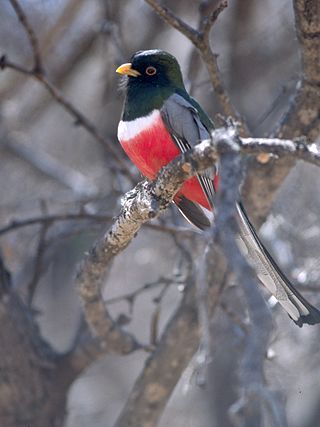
The elegant trogon, previously known as the coppery-tailed trogon, is a near passerine bird in the trogon family native to Central America. The etymology of the word trogon comes from the Greek word trōgein, meaning "to gnaw", which describes how this species prepares its nests in trees.

Trogon is a genus of Coraciimorphae birds in the trogon family. Its members occur in forests and woodlands of the Americas, ranging from southeastern Arizona to northern Argentina.

The red-naped trogon is a species of bird in the family Trogonidae. It is found in Brunei, Indonesia, Malaysia, and Thailand. Its natural habitat is subtropical or tropical moist lowland forests. It is threatened by habitat loss.
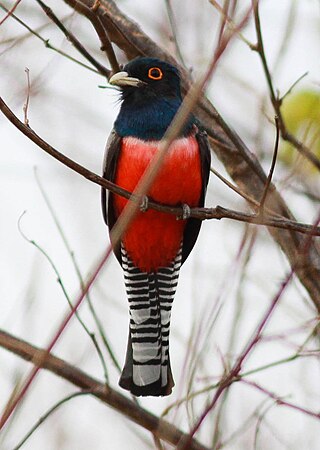
The blue-crowned trogon is a species of bird in the family Trogonidae, the quetzals and trogons. It is found in Brazil, Argentina, Bolivia, Colombia, Ecuador, Paraguay, and Peru. As with all trogons, this species is sexually dimorphic. The male has a blue head with an orange orbital ring, a red belly with a narrow white breastband and a green back. The female differs in having a grey head, a grey back and a broken white eye-ring.

The mountain trogon, also known as the Mexican trogon, is a species of bird in the family Trogonidae. First described by William John Swainson in 1827, it is resident in Guatemala, Honduras, and Mexico and has occurred in El Salvador as a vagrant. Like all trogons, the mountain trogon is sexually dimorphic. The male is metallic green on the crown, nape, upperparts and chest, the latter separated from its bright red belly and vent by a narrow band of white. The female is warm brown on the head, upperparts and chest, separated from its paler brown lower chest and red belly and vent by a narrow white band.
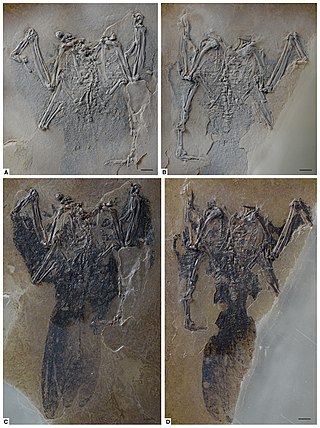
Archaeotrogonidae is a prehistoric bird family known from the Eocene and Oligocene of Europe. They are members of Strisores, and are thought to be closely related to nightjars.
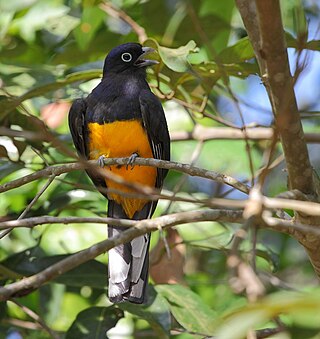
The green-backed trogon, also known as the Amazonian white-tailed trogon, is a bird in the trogon family Trogonidae. It is widely distributed across the Amazon rainforest with a disjunct population on the southeast coast of Brazil. As with all trogons, this species is sexually dimorphic. The male has a yellow belly without a white breastband, a blue head with a pale-blue orbital eye-ring, a blue bill, a green back and a green tail that is mostly white below. The female is duller with a dark grey head, a dark grey back and some black barring beneath the tail.

Nymans is an English garden to the east of the village of Handcross, and in the civil parish of Slaugham in West Sussex, England. The garden was developed, starting in the late 19th century, by three generations of the Messel family, and was brought to renown by Leonard Messel.

Palaeoamyda is an extinct genus of softshell turtle belonging to the family Trionychidae. Remains have been found in the Eocene of Germany.
This is an overview of the paleofauna of the Eocene Messel Formation as explored by the Messel Pit excavations in Germany. A former quarry and now UNESCO World Heritage Site, the Messel Formation preserves what once were a series of anoxic lakes surrounded by a sub-tropical rainforest during the Middle Eocene, approximately 47 Ma.
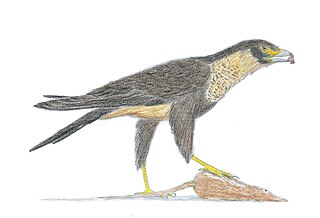
Masillaraptoridae is an extinct family of stem-group falconiform birds from the Eocene of Europe. They are noted for their relatively long legs. Two genera have been named: Danielsraptor, from the London Clay of England, and Masillaraptor, from Messel Pit in Germany.


















